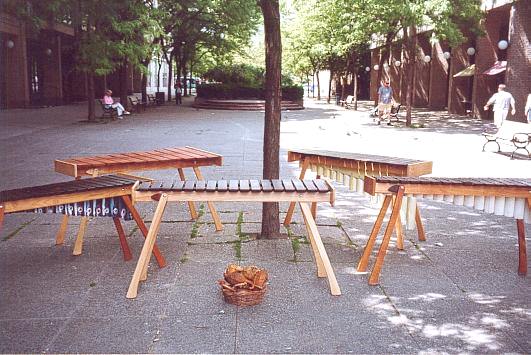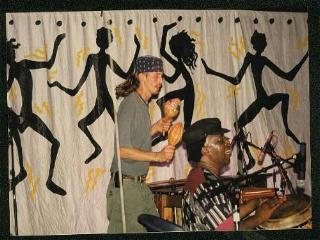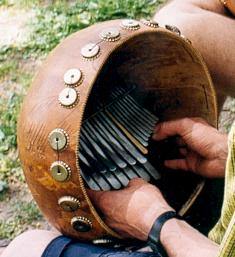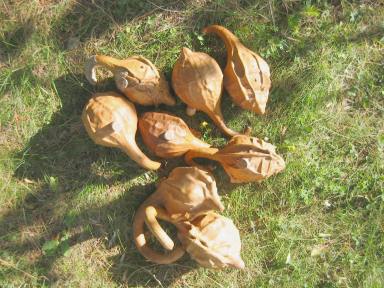

the marimba (mar-im-ba)

The Marimba belongs to a family of instruments that includes
Xylophones. As
an instrument, Marimba
has quite a facinating and international history - appearing in varied but
similar forms in many cultures and countries.
The style of Marimba we play is has origins primarily in
Zimbabwe. While most of our songs are contemporary compositions,
some of the music we play was originally composed and played on Mbira (See
"Mbira" below) - an instrument dating back several centuries with the
Shona of Zimbabwe. This music has only recently been transcribed (circa 1960's)
to the Marimba.
Quite often when we play people come from blocks
around to find out "What's making that sound?" In describing the sound of Marimba's, people offer up a
range of comparisons from woodwinds to pipe organs. We're
surprised how far it carries. Some listers are quite surprised to find that a
sound that big comes from wooden keys. It's best an outdoors/large space
instrument.
Needless to say, the sound is unique... When we play, people are often eager to share their thoughts
and even more eager to try. Listeners often comment on the joy and energy they
hear and feel from the sounds. For some the music soothes and for others it
energizes.
Alport
Mhlanga played
a significant role in the revival and development of the Marimba in Zimbabwe -
bringing it back from near extinction in the early 1960's. Many of his students
have gone on to compose and share the music around the world. He currently
resides and teaches in Botswana, South Africa. Nyamamusango
was greatly honoured to have met and worked with Alport on his 2002 visit to Ontario and the East
coast of the USA with the Map Marimba Band.
Dumisani
Maraire (A
student of Alport's) was among the first to bring this music to the West Coast
of Canada and the USA from Zimbabwe over 12 years ago. Many others have
come and shared since then.
We are thankful for their gifts.

Dumi and Dean Samuel (Marimba Muzuva) @ Zimfest 1999
Marimbas have between two and three octaves of
wooden keys, sometimes arranged in simple scales (e.g. piano white keys only)
or fully chromatic scales (e.g. piano white and black keys). The fully
chromatic Marimbas are more common in South America and on
concert marimbas. Marimbas belone to the same family of intruments as
xylophones and vibraphones. Our Soprano and Tenor Marimbas have 2 complete
C-C-C scales with an extra F# in each scale. The ALto and Baritone and Bass all
have between 1-2 octaves - stretching higher (Alto) or lower (Baritone, Bass)
as per the instrument. The instuments are approx 4-5ft in length and about 3ft
tall.
The keys are made from three types of wood: padauk
(soprano), wenge (tenors) and mahogany (baritone and bass). Other
woods have used for the keys include Red Cedar and Purple Heart. Our Marimbas were built by one of our members - Tim. White ash is used for the frame.
Each key is cut and tuned by grinding a groove in the underside.
The resonator pipes are made from
ordinary PVC drain pipes fitted with wooden plugs and plastic buzzers for
tuning and effect.

mbira (em-beer-ah)

Most of our members play Mbira as well as
Marimba. One of our members Dan, plays regularily with the Toronto Mbira
Sessions - a group of 5-6 players.
Mbira Dzavadzimu ("Mbira of the
Ancestors") dates back many centuries with the Shona of Zimbabwe. Though
traditionally used in ceremony, Mbira have become part of popular culture. The
term "thumb piano" is often used to describe these types of
intruments. Though not an entirely accurate term, it's more familiar.
The Mbira consists
of a set of metal keys fitted to a wooden soundboard. The keys can
be made from iron, copper, steel or brass. Mbira
most commonly consist of three rows of metal keys (22-28 in total), attached to
a rectangular soundboard made of wood usually Muqwa. You will often see metal beads, pebbles, shells or even
bottle caps attached to the Mbira to produce a rattling or buzzing sound. The Mbira is played by plucking the keys with your
thumbs and right forefinger.
The sound of Mbiras are often compared to the sounds
of a waterfall. The rhythms are quite often rolling and hypnotic. When several
instruments play together muti-faceted patterns are created.
Every Mbira is unique as per the design of the maker
- the may choose to build with thicker, flatter, rounder, ridged or wider keys.
In addition, individual builders may choose to tune their Mbira a certain way - either by pitch or key
set-up. Some Mbiras tuned to play specific songs. Each Mbira offers the creative
player almost infinite variations and possiblities. The Mbiras we play were built by Gift Rushambwa and
Phillimon Tirikoti of Zimbabwe and Leonard Nicoll of British Columbia
As with the Marimba, variations of this instument exist all
over Africa and Asia where corn stems, wooden strips or pieces of bamboo are
used instead of metal keys. Other names for
this type of intrument include kalimba and Ilimba.
Mbira are usually played mounted inside a
Deze - a calabash resonator (calabash is a type of gourd common
all across Africa). In recent years more durable (and lighter) fibreglass
resonators have become popular. The outside edge of the Deze is often decorated
with cowrie shells or more commonly bottlecaps. The bottle caps give a buzzing
effect and the caps from Zimbabwe are also quite interesting to look at - a
glipse of another culture's method of refereshment ("spirited" and
otherwise).
A significant figure in Mbira playing is Stella Chiweshe who has been very
active not only in bringing the Mbira back to the people of Zimbabwe (jsut over
35 years ago the playing was illegal and punishable by prison) but also in
literally putting this intrument in to the hands of women. Stella is held with
high regard and is nicknamed "Ambuya Chinyakare" (Grandmother of
Traditional Music).
The calabash in it's many shapes and sizes is used
both musically and practically throughout Africa and Asia. The gourd ranges in
usage from music (as resonator or percussive instrument) to food storage and
eating to water gathering - very versatile! There are a few calabash/gourd growers in North
America -who grow for the musical and decorative industries. The best (thickest
shells) come from Africa.
hosho
(hoe-show)

Hosho are gourd shakers
made from the Maranka plant and filled with Hota seeds (from a variety of Lily
called the Hope Lily). Each hosho is uniquely shaped ranging from smooth curves
to horn-like points and ridges. The seeds used to fill the Hosho are absolutely
rock hard (one variety of the seed was used as shot for the "Blunderbuss
rifle of days gone by) The Hota grows wildly in Zimbabwe. Some US and Canadian
Westcoasters have been successful in growing both Hosho and Hota.
The Hosho are surprisingly loud for their size and are important for keeping
the pulse of the music. They appear both durable (they take quite a shaking)
and fragile (they are at the least, dried gourds) at the same time. A hosho
player watches and treats their wares very carefully and may be very reluctant
in sharing with others. This shouldn't be taken personally - hosho are hard to
come by in Toronto. We've had to do a few epoxy repairs over the years.
Someone once
joked the reason the music moved from Mbira to the much louder and larger
marimba was to compete with the volume of the Hosho.


the group; instruments;
images; performances; listen;
links; contact; home
All content copyright L. Hurley 1999-2005


![]()


![]()
![]()